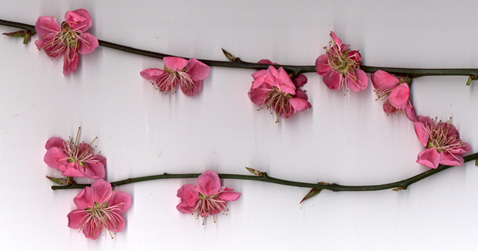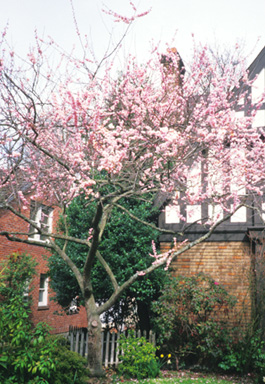Plant of the Month: March 2005
|
| Japanese Apricot |
Prunus Mume (Sieb.) S. & Z.
|
= Armeniaca Mume Sieb.
|
(ROSACEÆ); Rose Family
|
| This species is cultivated primarily as a flowering tree, an ornamental. The Japanese Apricot or Japanese flowering-apricot is also called the Japanese plum tree --a name usually applied in the West to Prunus salicina. Nor is the species native to Japan; it is from China (called "Mei" 梅), Korea, and a variety grows in Taiwan. It was named by Siebold in 1828 (Mume or ume is Japanese vernacular), and introduced by him from Japan to Holland between 1841 and 1844. It has been in North America since 1911 if not before. Uncommon here overall; over the decades at least 34 cultivars have been offered for sale, most little known and very rare. Seven better known and in contemporary commerce are listed below. In addition, a well known hybrid Japanese Apricot bearing purple leaves and double, fragrant pink flowers is Prunus x blireiana. |
| In Japan Prunus Mume is the Royal Crest, is widely cultivated (more than 300 cultivars), and greatly beloved. It is February's floral emblem. It is smaller and more slender than the common apricot tree (Prunus Armeniaca), and is usually a low bushy tree to 15 feet tall; but can be twice as tall and just as wide. A specimen received in 1959 at the Los Angeles arboretum was measured in 1993 at 28.5 feet tall, its trunk 3 feet 5 inches in circumference, and its branch spread 27.5 feet wide. The largest I know in Seattle (though not tallest) is currently only 21.5 feet tall, its trunk 3 feet in circumference, and its branch spread 27 feet wide (photographed below). |
| The flowers are pale pink (varying much in cultivars to snow white, deep pink or red), and are often richly fragrant with sweet spicy odor suggesting a carnation. They bloom relatively early in spring, usually in February or March. Though the wild form has only 5 petals, many cultivars are semi- or fully double, bearing extra petals. After the flowers are done the leaves flush out. |
| At maturity, the leaves measure up to 4.5 inches long by 3 inches wide, are edged with fine teeth (usually sharp), and bear a characteristic "pinched" apex. In a nomenclatural sense, typical Prunus Mume has its leaf hairy on both sides, and is yellowish-green in color. But this is actually rare. The more common form, in 1921 technically named by Alfred Rehder var. tonsa, has a quite or nearly hairless leaf except near the base of the midrib beneath. The leaf is also narrower, and gray-green colored. In botanical Latin the term tonsa means shaven, hence becoming hairless. |
| The ripe apricots are yellow to orange or red, 1 to 1.5 inches, fuzzy-skinned, cling-stone; usually poor quality as fresh food, and though attractive on the tree, fall and prove messy if not harvested. In Seattle they ripen mid- to late July. Harvested while still green and then pickled, the fruit is esteemed in Japan. I have a tree with single darkest pink if not reddish single to semi-doubled flowers (see scan), that in 1987 I raised as a seedling from a tree that bore pale pink fully doubled flowers. My tree makes plentiful fruit, and I let them dry, then eat them as dried apricots. |
| As for disease, at least in Seattle the tree is hurt mostly by bacterial canker, also known as bacterial blight (Pseudomonas syringae). To combat this bacterium a person can get a backpack sprayer or a compressed air sprayer, and give the tree a spray of copper oxychloride or copper hydroxide (just ask at the garden center for a copper fungicide). Do a spray about September, another around the time the leaves drop, and once or twice before the flowerbuds open in February or March. There is also brown rot (Monilinia) a fungus that is most effectively dealt with by a fungicide applied as the flowerbuds swell, and at full bloom. |
If you hate spraying, as I do, just site your tree in a sunny location with good air circulation, and diligently prune off any dead twigs, and pluck any shriveled rotting blossoms. The following 7 cultivars likely vary in disease susceptibility, but I am aware of no comparative studies.
|
'Bonita' Probably came from Japan but was named in 1940 by W.B. Clarke nursery of San Jose, CA. Still in commerce. Named after one of Clarke's three daughters. Flowers double, deep red, deliciously fragrant. Leaf barely hairy. Tree somewhat dwarf.
|
'Dawn' Originally from Japan and is said to be known there as 'Musashi-nono' but was named 'Dawn' about 1929 by W.B. Clarke. Still in commerce; among the commonest of all. Flowers about 1.5 inches wide, rich clear pink, very double. Petals exquisitely ruffled; delightfully fragrant. Blooms the first week February. Leaf hairless. Tree somewhat dwarf.
|
'Kobai' In North American commerce in or before 1991. Flowers variously described as "double, light pink, profuse;" "semi-double, red;" "vivid rose-pink;" "single, pink."
|
'Matsubara Red' ('Matsubana Red') In North American commerce in or before 1970. Flowers red, early, seven-eighths of an inch wide, semi-double; calyx blood-red. Young foliage reddish. Leaf hairless. Twigs purple.
|
'Peggy Clarke' Introduced to North American commerce in 1941 by W.B. Clarke. Still in commerce. Named after one of Clarke's three daughters. Flowers double, deep rose, medium-sized, somewhat cupped; calyx red; extremely long stamens. Blooms 2 weeks after 'Rosemary Clarke' and has smaller flowers. Leaves hairless.
|
'Rosemary Clarke' Introduced to North American commerce in 1938 by W.B. Clarke. Still in commerce. Named after one of Clarke's three daughters. Flowers 1 and one-eighth to 1.5 inches wide, semi-double (about 16 petals), snow white; rosy-red calyx; intensely fragrant.
|
'W.B. Clarke' In North American commerce in or before 1980. Named after California nurseryman Walter Bosworth Clarke (1876 - 1953). Flowers double, pink. Leaves hairless. Habit weeping. Doubtless a renaming of one of two weeping, fully double cultivars that Clarke had introduced to North American commerce in or before 1939: 'Weeping Double Pink No. 201' (pure peach-blossom pink, blooming about a week or 10 days earlier than 204) or 'Weeping Double Pink No. 204' (pink, blooming about a week or 10 days later than 201).
Back |

Prunus Mume scan by ALJ
|

Prunus Mume 'Dawn' photo by ALJ
|
|
|

